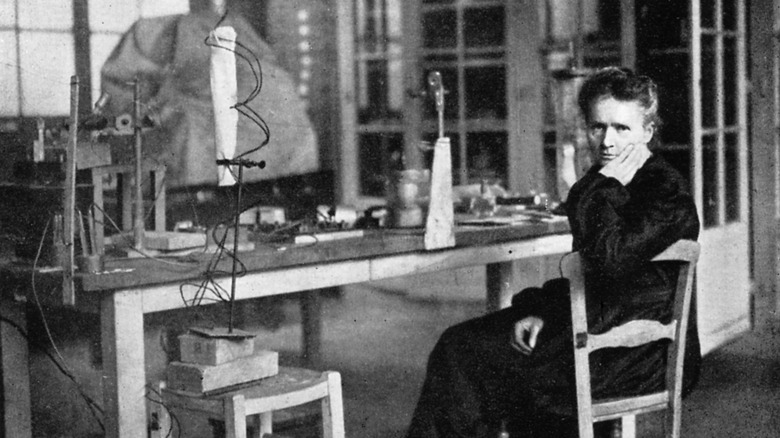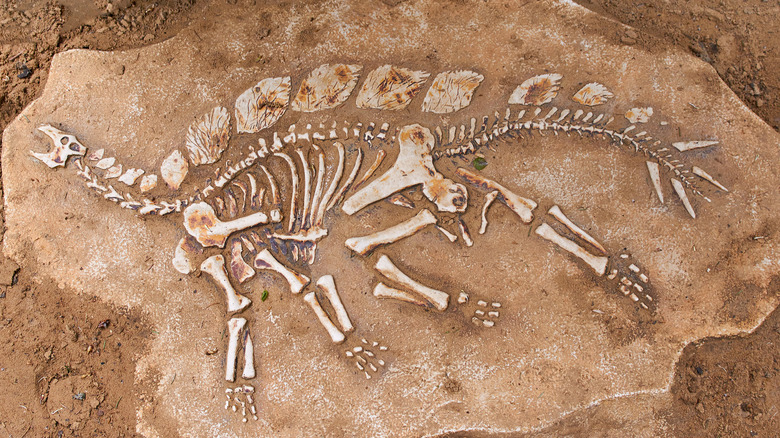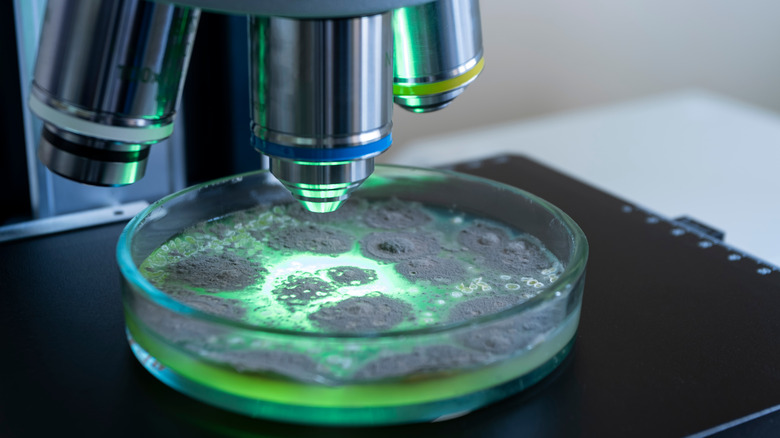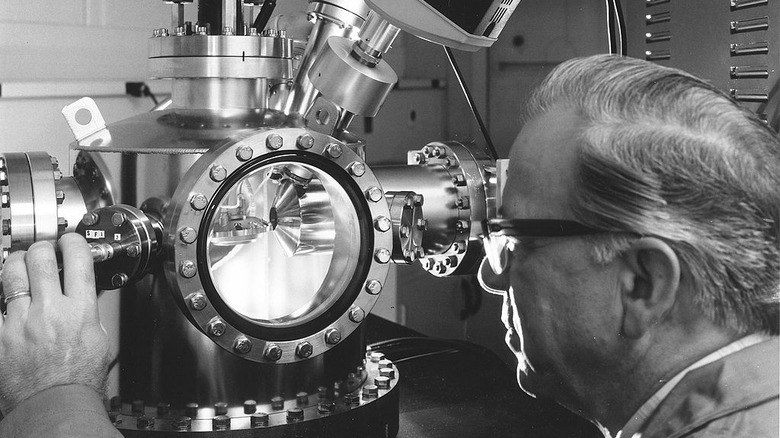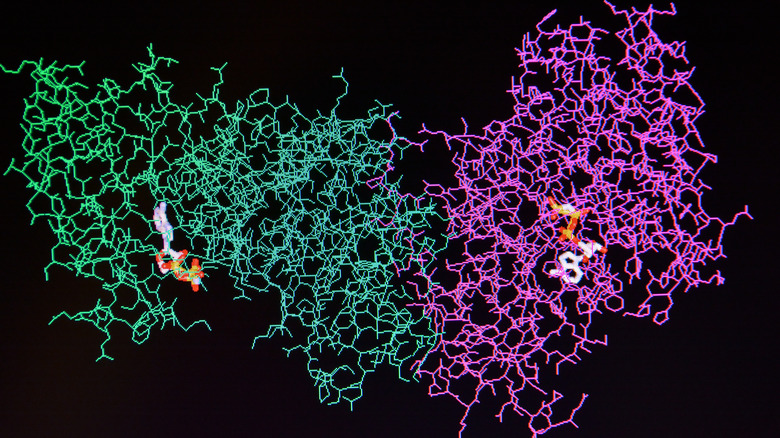These Were The Biggest Scientific Breakthroughs Of 1922
There's always something new happening in science, and that's part of what makes it such a fun field to keep an eye on. You never know when there might be some new animal species discovered, when a strange new world might be spotted out in space, or when there might be some crazy new technological update to our phones and laptops. Advancement and discovery is the name of the game, after all, and it always has been.
So if you were to jump back into history by a hundred years, you'd see that scientists then weren't all that different from scientists now, always chasing after new and strange and inventive ideas in all sorts of fields. From medicine to chemistry to paleontology, plenty of breakthroughs were being made all across the board, and the effects of those discoveries could be felt in the decades that followed (and can even still be felt well into the 21st century). So here are just a few of those scientific advancements that came out of the year 1922.
Mathematical weather forecasting
Everyone complains about the weather. Everyone is also pretty familiar with the reason for that complaining being because the local meteorologist was completely wrong about the weather for the day. But not having any sort of weather forecast would probably be worse. British physicist and mathematician Lewis Fry Richardson is the man to thank for creating the system that's around today.
Per The Guardian, Richardson is especially well known for his 1922 publication called "Weather Prediction by Numerical Process." In that book, he did away with the traditional version of weather forecasting (educated guesses based on past trends) in favor of mathematical models based on things like the flow of water. He even demonstrated his models ... only for his predictions to be complete disasters. According to the Irish Times, he solved his own equations by hand and came up with entirely unrealistic pressure changes, and Britannica adds that it took him three months to predict the next day's worth of weather.
Basically, there was just too much information for one man to parse accurately. Which was why he dreamed of creating a "forecast factory" to house tens of thousands of mathematicians, constantly running the numbers in order to keep up with live weather changes and directed by a swinging, synchronized spotlight. Granted, that idea is kind of ridiculous (and probably wouldn't have worked), but Richardson would eventually see his dreams somewhat realized. After all, his theories were mathematically and physically sound. With some small adjustments, modern computers are able to handle his complex models, which still provide the basis for current-day weather forecasting.
Compton scattering
If you're not deeply entrenched in the world of science (quantum mechanics, in particular, which means this starts getting into that weird end of science), then you might not have heard of the Compton effect. But maybe you're more familiar with the name Albert Einstein. See, one of the things that Einstein added to the scientific field was this idea of wave-particle duality – the concept that light is more than just a wave. Rather, it's also a packet (or particle) of pure energy, and it somehow contains the qualities of both a wave and a particle (via Britannica). Strange stuff, for sure. Einstein had come up with experimental evidence for his claims back in 1905.
But in 1922, the American physicist Arthur Holly Compton began some tests based on a few of Einstein's theories, shooting X-rays at a sheet of metal (via Nobel Prize). Doing so knocked electrons off of the metal, but it also scattered those X-rays back at a lower energy. There's an entire process to explain what's happening which gets into some physics details, but according to Britannica, essentially, those little packets of energy run into electrons and get knocked around. New, lower energy packets are produced and thrown off the metal in (ultimately) predictable patterns, and those patterns are best explained by thinking of those X-rays as both a wave and a particle. This effect – also called Compton scattering – helped to lay a lot of groundwork for modern-day quantum physics.
Compton published an article about his discovery a year later, and it won him the Nobel Prize in 1927.
Discovery of multiple dinosaur fossils
It doesn't seem like a stretch to say that most people think dinosaurs are pretty cool, and any time you get to see the fossilized skeleton of one of these beasts, there's a sense of wonder that can't quite be matched by anything else. Well, lucky for all of you who like dinosaurs, 1922 was a pretty good year for paleontology.
To start off with, there was the discovery of a number of new dinosaurs. The American Museum of Natural History lists the Protoceratops – the ancestor to the more widely recognized Triceratops – and the Field Museum also makes mention of the "little carnivorous dinosaur" known as the Gorgosaurus (but more affectionately known as "Elmer"). Then, there are some other fun discoveries, like those made at the Flaming Cliffs in the Gobi Desert – namely, the recovery of fossilized dinosaur eggs. According to the Embryo Project Encyclopedia, those eggs provided some of the first looks into the reproductive tendencies of dinosaurs, and scientists were able to guess that dinosaurs tended to lay large groups of eggs at a time, much like modern-day crocodiles do.
All of that said, though, 1920s paleontology has an even stranger legacy. Roy Chapman Andrews – the man who led the Central Asiatic Expeditions into southern Mongolia and the Gobi Desert – was something of a celebrity. According to National Geographic, Andrews was apparently so charismatic that George Lucas would later use him as inspiration for the character of Indiana Jones. Weird, right?
Degesch files a patent for Zyklon B
According to the National WWII Museum, on June 20, 1922, a German company by the name of Degesch filed a patent for a chemical called Zyklon B (via Kenyon) – that patent would be awarded four years later. As ThoughtCo explains, Zyklon B really doesn't seem like anything too interesting on the surface; up until – and through – World War II, it was a pesticide and disinfectant, used to clean everything from clothing to entire ships and warehouses. In the past, similar chemicals had even been used to fumigate train cars and clear California citrus farms of unwanted insects.
So, what's the big deal? Well, those chemicals used in the past were actually forms of hydrogen cyanide – a substance weaponized by Germany in World War I and, consequently, banned from production. Zyklon B was basically a clever new formula that was just different enough for Degesch to file for their patent. And as for why this patent for Zyklon B, in particular, was so important – that has to do with just what this chemical was used for in the decades to come. See, Zyklon B came in blue, crystalline pellets stored in sealed metal canisters; exposure to air made those pellets turn to gas.
Maybe the relevance is starting to make a little more sense. After all, you've got Germany, chemical weapons, and dangerous gases. Zyklon B shortly became a weapon of mass murder. Starting in 1941, huge groups of prisoners would be rounded into airtight rooms, pellets of Zyklon B thrown in with them. The deadly gas could suffocate hundreds of prisoners in a matter of minutes, and millions died in the fumes over the years.
Vitamins D and E
At this point, you're probably pretty familiar with the idea of making sure you get your vitamins as part of a healthy, balanced diet. You know, that laundry list of a bunch of different things everyone should make sure they're getting in their foods: vitamin A, vitamin B, vitamin C, CoQ10, calcium, and so on and so forth. The thing is, all of those vitamins being seen as so important is a pretty new invention, according to ThoughtCo. This whole idea came about around the start of the 20th century, with a number of different scientists putting together the connection between different nutrients from food and general health. In other words, being short on one of those particular nutrients could lead to sickness.
While a bunch of different vitamins were discovered in the first half of the 20th century, both vitamins E and D were found in 1922. According to the New York Times, vitamins A, B, and C had been identified, but a number of researchers were looking for a fourth vitamin. This fourth vitamin, D, was "captured" on June 19 by a biochemist looking into the prevention of the bone disease called rickets (vitamin D has to do with the absorption of calcium), though it was also found by a separate group who had linked the same vitamin with sunlight exposure.
Vitamin E, meanwhile, was discovered by two researchers at the University of California who were looking into fetal development in pregnant rats (via "A History of Vitamin E"). It was discovered to also be an important antioxidant largely found in leafy green vegetables – basically, something that people should make sure to include in their diets.
Lysozyme
If you've never heard of the enzyme called lysozyme, you'd probably be pretty easily forgiven. After all, it's not like it's getting mentioned on a daily (or weekly, or monthly) basis by most people. So, what's it doing on this list? Well, that would be its relation to a far more recognizable name: Alexander Fleming.
In 1922, Fleming was beginning his research into disease and bacterial growth, and, as an article published in the Singapore Medical Journal tells it, he didn't have the most meticulous of lab etiquette. Supposedly, a drop of mucus from his nose fell onto a petri dish, which was then lost and allowed to grow colonies of bacteria for a couple of weeks. And when he rediscovered that petri dish, he was in for a surprise; all of the bacteria around that drop of mucus had been killed. Further tests revealed that the same bacteria-killing substance was also in tears and saliva, and it was able to do the job without harming human cells (via Scottish Science Hall of Fame). Fleming was fascinated by his find and named this new antibiotic "lysozyme," but, unfortunately, his colleagues were less impressed. Lysozyme could kill some bacteria, yes, but none of the stuff that's really harmful to humans.
Fleming himself actually noted that in the Nobel Lecture he gave over 20 years later, though it's also worth mentioning that he decided to bring up lysozyme at all. Although his first antibiotic wasn't a hit, it did prove "of great use to [him]" because all of the same techniques he used to study lysozyme eventually got reused for his far more famous discovery: penicillin.
The Auger effect
When you hear the term "Auger effect," it's probably easiest to assume that it's some complicated science phenomenon invented or discovered by a researcher named Auger, right? And if you were to read about it on Britannica, that seems to be the case: It was named after the French physicist Pierre-Victor Auger, but he didn't discover the effect until 1925. So what gives?
Well, if you read a little deeper into history, Auger wasn't the first to discover this phenomenon. Rather, Austrian physicist Lise Meitner beat him to the punch by a few years. One of very few women to receive a doctorate degree in early-20th-century Europe, Meitner worked as a nuclear physicist, studying the process of nuclear fission (via Atomic Heritage Foundation). That work would get her nominated for multiple Nobel Prizes, according to an article published in Physics Today, but in the process, she also noticed something strange about atoms bombarded with energy. Without getting too deep into the complicated science, atoms can eject electrons, and doing so can sometimes cause all of the other electrons to rearrange themselves, that shuffling leading the atom to also emit some radiation. Meitner first wrote about the effect in 1922 and 1923, but the discovery went under everyone's noses, since she was focused on some of the particular emissions, rather than the electron re-shuffling.
That said, she did discuss it with other scientists – including Auger, who went on to study it himself. It would be named after him some years later (though arguments exist to change the name to the "Auger-Meitner effect").
Discovery of King Tut's tomb
November 1922 was really quite an exciting time in archeology. After all, everyone's heard of the famous King Tut, but, as ThoughtCo explains, back in the early 20th century, no one could even be sure that the mythical tomb even existed.
That's where British archeologist Howard Carter came in. Along with his sponsor, Lord Carnarvon (himself an amateur archeologist), Carter began excavations in the Valley of the Kings. Following a trail of breadcrumbs – or, rather, a trail of artifacts that bore the name of the famous pharaoh, Carter and Carnarvon kept looking for five years, even as it seemed like their persistence would be in vain.
But their patience paid off, and per History, on November 4, Carter ended up finding a mysterious set of stairs hidden in the rubble of King Ramses VI's tomb. He spent a couple of weeks keeping the find a secret, waiting for the approval from Carnarvon to continue excavating, and on November 24, both Carter and Carnarvon finally entered the tomb. There, they found seals with Tutankhamun's name, more or less confirming what they'd all dreamed, and the excavations continued, revealing thousands of treasures – golden statues, boxes, furniture. But the most important find? That came on November 26, when the team entered the actual burial chambers, finding three coffins, one of which was made of solid gold and carried the mummy of King Tut himself.
Macromolecules
The stance on plastics in the current day and age is complicated, to say the least. Pollution – including the Great Pacific Garbage Patch, the island of trash floating around in the ocean (via National Geographic) – isn't something to ignore, and everyone has seen enough images of sea creatures with pieces of trash around their necks. Plastics definitely play a part in that, but at the same time, it's hard to ignore just how prevalent they are in everyday life; love them or hate them, it's hard to really navigate the modern world without running into plastics and rubbers.
But before the rise of the plastics industry as it's seen in the 21st century, no one really knew how these materials – polymers – worked. The Science History Institute explains that scientists assumed that all materials, including rubbers and other polymers, were just a bunch of smaller molecules all smashed together tightly enough – or in just the right way for electrons to interact favorably (via Britannica) – to develop the squishy nature of rubber.
That's where German chemist Hermann Staudinger came onto the scene. In 1922, he proposed that everyone was thinking about the problem wrong. Rather than a bunch of smaller molecules aggregated together, these were "long, chainlike structures" held together with chemical bonds, which he termed "macromolecules." The rest of the scientific community pushed back against his idea, but further research kept piling up to support his theories, as did the creation of synthetic polymers by DuPont. Ultimately, aside from the plastics industry, Staudinger's work opened the door for the creation of the fields of polymer chemistry and molecular biology.
Treatment of diabetes with insulin
Now, in the 21st century, insulin is pretty widely known as the main treatment for diabetes, and diabetes itself – while not something to disregard by any means – is something that most people can expect to survive. But in the past, that wasn't really the case. Though Medical News Today explains that type 1 diabetes was probably observed as early as 3,000 years ago in ancient Egypt, it never had a cure or a treatment. Up to the 19th century, there were still a lot of questions surrounding diabetes and how common it was, so a diagnosis was pretty often a death sentence, and the best doctors could recommend were some lifestyle changes (which weren't all that effective).
Fortunately, things really started changing in the 1920s, and it was discovered that insulin-producing cells in the pancreas were destroyed in patients with type 1 diabetes (via Diabetes UK). Canadian surgeon Frederick Banting also theorized that insulin could be extracted, and that theory led to the successful extraction (and purification) of insulin.
All that remained was to put that insulin to use. The research team had successfully treated a dog with diabetes, and on January 11, 1922, a 14-year-old boy named Leonard Thompson was the first human patient injected with insulin in order to treat type 1 diabetes. The results were promising, though there were some minor complications. After further purifying the insulin, Thompson was given a second injection less than two weeks later, with resounding success. Just a few months later, insulin was being mass produced, and in 1923, the discovery proved worthy of a Nobel Prize.
